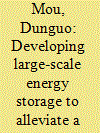|
|
|
Sort Order |
|
|
|
Items / Page
|
|
|
|
|
|
|
| Srl | Item |
| 1 |
ID:
150002


|
|
|
|
|
| Summary/Abstract |
National carbon mitigation policy included in the Clean Power Plan (CPP) targets electric power generation facilities and may have substantial impacts at the national level. The subnational impacts will vary because the level of dependence on coal for electricity generation varies substantially across states. Indiana represents a state where the CPP impacts may be relatively large due to heavy dependence on coal for electricity generation. Therefore, this paper presents analysis of the efficacy and cost of alternative approaches to carbon mitigation policy, taking Indiana as an example.
|
|
|
|
|
|
|
|
|
|
|
|
|
|
|
|
| 2 |
ID:
127872


|
|
|
|
|
| Publication |
2014.
|
| Summary/Abstract |
Maximizing renewables in the country's power system has been a key political agenda in Japan after the Fukushima nuclear disaster. This paper investigates the potential of PV resource, which could be systematically integrated into the Japanese power system, using a high time-resolution optimal power generation mix model. The model allows us to explicitly consider actual PV and wind output variability in 10-min time resolution for 365 days. Simulation results show that, as PV expands, the growth of PV integration into the grid slows down when the installed PV capacity is more than the scale of the peak demand, although Japan has immense potential of installable PV capacity - equivalent to 40 times of the peak. Secondly, the results imply that a large-scale PV integration potentially decreases the usage ratio of LNG combined cycle (LNGCC) in specific seasons, which is a challenge for utility companies to ensure that LNGCC is used as a profitable compensating generator for PV variability. Finally, a sensitivity analysis on rechargeable battery cost suggests that the reason for suppressing the PV output instead of storing its surplus output by the battery can be attributed to the high battery cost; hence, the improvement of its economic performance is significant to integrate the massive PV energy.
|
|
|
|
|
|
|
|
|
|
|
|
|
|
|
|
| 3 |
ID:
114034


|
|
|
|
|
| Publication |
2012.
|
| Summary/Abstract |
The authors discuss improvements in the Russian troops' combat gear and show ways to be followed in research to design soldiers' combat gear for the 21st century.
|
|
|
|
|
|
|
|
|
|
|
|
|
|
|
|
| 4 |
ID:
176722


|
|
|
|
|
| Summary/Abstract |
The UK has some of the worst performing residential buildings in the EU from an energy efficiency perspective. Natural gas remains a dominant feature of existing and new-build housing with strong historical, technical, and social barriers to change. Consequently, the residential sector is responsible for significant shares of national emissions and has a strong role to play under ambitious net zero targets.
|
|
|
|
|
|
|
|
|
|
|
|
|
|
|
|
| 5 |
ID:
166934


|
|
|
|
|
| Summary/Abstract |
By taking the grid system in Fujian Province as an example, this paper establishes a power market system model to simulate the impact of nuclear and wind power on the system operation. The article employs the method of optimal power flow (OPF) analysis, under a framework of social welfare maximization with close-to-reality thermal power generation cost and technical constraints. The simulation results show that large-scale nuclear power can reduce the level of electricity prices and improve the difference in regional electricity prices; as a result, the thermal power can be in an unfavourable position and therefore undertake peak and load following; meanwhile, the development of large-scale wind power would increase the demand for following of load and valley load. Moreover, the simulation for the operation of the electricity market shows that in the case of electricity oversupply, the thermal power can be deliberately bid at a low price, and the nuclear power would assume the obligation of valley load following, even with the presence of PSHPs in the system; thus, the low-carbon energy can't be fully utilized. In conclusion, the general bidding model in the electricity market cannot be applied to the situation of long-term electricity oversupply.
|
|
|
|
|
|
|
|
|
|
|
|
|
|
|
|
| 6 |
ID:
128049


|
|
|
|
|
| Publication |
2014.
|
| Summary/Abstract |
The benefits of using a combined cooling, heating, and power system with dual power generation units (D-CCHP) is examined in nine different U.S. locations. One power generation unit (PGU) is operated at base load while the other is operated following the electric load. The waste heat from both PGUs is used for heating and for cooling via an absorption chiller. The D-CCHP configuration is studied for a restaurant benchmark building, and its performance is quantified in terms of operational cost, primary energy consumption (PEC), and carbon dioxide emissions (CDE). Cost spark spread, PEC spark spread, and CDE spark spread are examined as performance indicators for the D-CCHP system. D-CCHP system performance correlates well with spark spreads, with higher spark spreads signifying greater savings through implementation of a D-CCHP system. A new parameter, thermal difference, is introduced to investigate the relative performance of a D-CCHP system compared to a dual PGU combined heat and power system (D-CHP). Thermal difference, together with spark spread, can explain the variation in savings of a D-CCHP system over a D-CHP system for each location. The effect of carbon credits on operational cost savings with respect to the reference case is shown for selected locations.
|
|
|
|
|
|
|
|
|
|
|
|
|
|
|
|
| 7 |
ID:
179662


|
|
|
|
|
| Summary/Abstract |
This study examines the impact of natural gas prices on the power systems of Mexico and the United States. For this, we develop an integrated modeling framework by soft linking three different techno-economic bottom-up models of the power and energy systems, one partial equilibrium model of the natural gas sector, and a partial equilibrium model of the Mexican energy sector. Our results show several interesting results: high natural gas prices raise the use of carbon-intensive technologies in the short-term and boost renewable investments at longer time intervals, increasing emissions in earlier periods and reducing them thereafter. Regarding system costs, because of more capital-intensive green power and lower expenditures in raw energy carriers, capital costs rise and operating costs decrease in the long haul. Furthermore, we see an increase in natural gas demand when its price is low, reducing long-term capital and operating costs through cheaper energy inputs in natural gas facilities and a lower share of capital-intensive renewable facilities in the power system. Concerning emissions, low natural-gas prices decrease coal use in the United States, reducing anthropogenic emissions until the last stages of the optimization period. For Mexico, they show heterogeneous results across models. Policymakers can use this study's results to understand the influence of natural gas prices in the Mexican and United States energy sectors.
|
|
|
|
|
|
|
|
|
|
|
|
|
|
|
|
| 8 |
ID:
124169


|
|
|
|
|
| Publication |
2013.
|
| Summary/Abstract |
China's electricity sector faces the challenge of managing cost increases, improving reliability, and reducing its environmental footprint even as operating conditions become more complex due to increasing renewable penetration, growing peak demand, and falling system load factors. Addressing these challenges will require changes in how power generation is planned, priced, and dispatched in China. This is especially true for natural gas generation, which is likely to play an important role in power systems worldwide as a flexible generation resource. Although natural gas is commonly perceived to be economically uncompetitive with coal in China, these perceptions are based on analysis that fails to account for the different roles that natural gas generation plays in power systems-baseload, load following, and peaking generation. Our analysis shows that natural gas generation is already cost-effective for meeting peak demand in China, resulting in improved capacity factors and heat rates for coal-fired generators and lower system costs. We find that the largest barrier to using natural gas for peaking generation in China is generation pricing, which could be addressed through modest reforms to support low capacity factor generation.
|
|
|
|
|
|
|
|
|
|
|
|
|
|
|
|
|
|
|
|
|